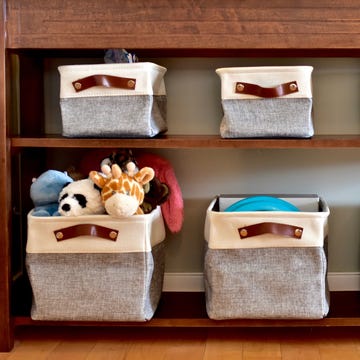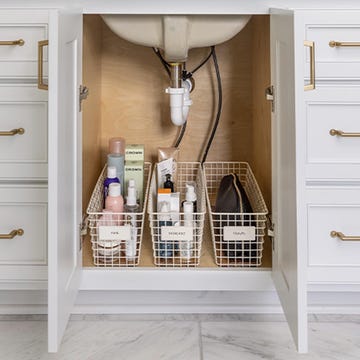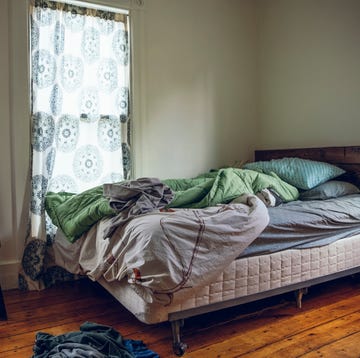As you grow older, you tend to outgrow what once served you. It’s a natural evolution; you change, so your preferences do, too. All of a sudden, everything, from the little details like how you take your coffee to how you decorate your living space, could use a refresh. According to designers, the latter is an especially pressing matter when a person turns the big 5-0.
“After 50, we've earned a curated life,” says Jennifer Fordham, CEO and principal interior designer at Pembrook Interiors. “We've developed the wisdom to be thoughtful in creating our surroundings, and frankly, we know what works and what doesn't. We no longer need to experiment with trendy pieces or waste money on items that aren't quite right. At this stage, we trust our instincts and understand how profoundly our environment affects our well-being.”
There’s no denying that with age comes wisdom, but leaning into that logic can prove difficult when you’re dealing with home decor that holds sentimental value. Still, Fordham says some things simply don’t belong in your home after 50. Combing through your space and eliminating items that don’t serve to create the “authentic, intentional environments that enhance daily living” that people in this age bracket so often crave will be beneficial to you in the long run. The question is, what goes?
Ahead, we’ve rounded up the top 12 things that interior designers say homeowners 50 and above should part with ASAP.
Fast-Fashion Decor
You know what we’re talking about: Mass-produced throw pillows with cheeky sayings, generic window treatments, and trendy wall art that wasn’t exactly your taste but worked for the space are all items Fordham says can (and should) go.
“At 50+, we can invest in custom window treatments that address our needs and fit perfectly, quality textiles that age beautifully, and art that tells our story rather than filling wall space,” Fordham says. “This isn't about spending more; it's about spending wisely on pieces that will serve us for decades and feed our soul.”
Mismatched Dish Sets and Single-Use Cooking Gadgets
Everyone accumulates random dishes that don’t match their sets over time, especially those who frequently host dinners and other gatherings. Keep your favorites, but donate the rest. The same goes for eclectic gadgets. The key, Fordham says, is to edit down what’s in your kitchen to only what serves you both functionally and aesthetically.
“We know how we cook and entertain. We understand which tools we reach for and which gather dust. Now we can create a cohesive, edited collection that makes every meal—whether for two or twenty—feel intentional and elegant.”
Harsh Overhead Lighting and Novelty Lamps
Fordham is adamant about this tip, stressing that sophisticated lighting is essential after 50. “Good lighting transforms not just how a space looks, but how we feel in it,” she says.
“Our eyes need more thoughtful illumination, and our refined aesthetic deserves better than builder-grade fixtures. Layered lighting—combining table lamps, sconces, and dimmers—creates the ambiance that supports both productive work and relaxing evenings. It's a design investment that pays dividends in daily comfort and wellbeing.”
Photo Frames
You don't have to get rid of all your photo frames—just the excess and outdated. According to Liz Williams, founder and principal designer of Liz Williams Interiors, if you have unflattering picture frames (think ornate silver pieces) on every surface, it ages your home in a bad way. Instead, Williams recommends selecting a few special images and investing in more elevated, streamlined frames, like linen, leather, rattan, or a modern lacquer. This way, Williams says, the photos will feel intentional, not crowded and busy.
Dated Gallery Walls
If your daughter’s school picture from when she was eight years old is still hanging on the wall, despite the fact that she’s now 30, it's time to swap to something more applicable to your current-day household. Lauren Winsor, the designer and owner at House of Winsor Interiors, says it's time to swap tired family galleries and canvases for collectible pieces from your travels, original art, favorite images reprinted in black and white, etc. “You've lived, laughed, and loved,” Windsor says. “Show us with pieces that reflect your unique experiences.”
A Futon
CEO and principal designer of Jensen & Co. Interiors, Isfira Jensen, tells House Beautiful that at this stage of life, comfort is a need, not a want, and your main seating should provide both proper support and generous cushioning. In other words, if you’re still sitting on a futon at the end of the day, swap it for a well-made sofa that “meets the standard of comfort or design that a living room should offer when you’re in your 50s.”
Mini Blinds
Mini blinds are made from cheap materials (typically aluminum or vinyl) that constantly rattle. They’re great for a starter apartment, Jensen says, but not, she stresses, a home that reflects refined taste. To upgrade, Jensen recommends opting for Roman shades or woven wood shades as either will “add subtle texture and sophistication to a room.”
Laminate Furniture
Another “no” for Jensen is laminate furniture, pieces that are made from synthetic materials to give the illusion of a higher-quality item. While they are quite affordable, Jensen observes they lack the warmth, character, and longevity of a natural material. “It attempts to mimic the look of real wood, stone, or lacquer, but up close, the illusion quickly falls apart,” Jensen says. “In elevated interiors, materials matter.”
Matching Furniture Sets
The days of matchy-matchy sets are over. “Identical sofa, loveseats, and chair sets look overly coordinated and impersonal,” says Jo Rich of Raydoor Sliding Walls & Doors. To give a richer, more inviting feel to a space, the designer recommends mixing a classic framed sofa with an accent chair in a complementary fabric or material.
Matching Hardware & Fixtures
While we’re on the subject of matching, Rich warns against coordinated hardware and fixtures, as she says they can feel “one-note.” Ergo, mix your metals! Think, a nickel faucet with matte black cabinet pulls. “Each finish should highlight the other, and the overall scheme should feel intentional and contemporary.”
Small Rugs
Tara Fust of Tara Fust Design recommends nixing your tiny rugs that are floating in a sea of hardwood. “If your rug doesn’t at least kiss the front legs of your furniture, it’s a 'tell'…and doing you a disservice,” she says. Fust’s foolproof advice: Size up, always.
Wall-to-Wall Beige
Say it with us: Color is your friend. Kerrie Kelly, the CEO and creative director at Kerrie Kelly Studio, stresses that while neutrals have their place, all-beige everything often falls flat. To make your space feel fresh, the designer recommends introducing richer tones or nuanced contrasts that add depth and warmth. This is something, Kelly points out, you’ve earned the confidence to embrace in your 50s. “[You can also] include items that have been collected while traveling or reflect your family heritage,” Kelly says. “Truly tell your style story.”
Julia Guerra is a New Jersey-based freelance writer with bylines across digital media sites such as InStyle, WWD, INSIDER Reviews, MindBodyGreen, and more. With over 7 years of writing across lifestyle verticals, she is forever testing and researching all things related to makeup and skincare, fashion, athleisure, women's health and wellness, as well as the best home gym equipment. When she's not writing articles, Julia can be found with her head in a book, obsessing over skincare, practicing yoga, taking pictures of her adorable cat, or spending time with her husband and loved ones.
















